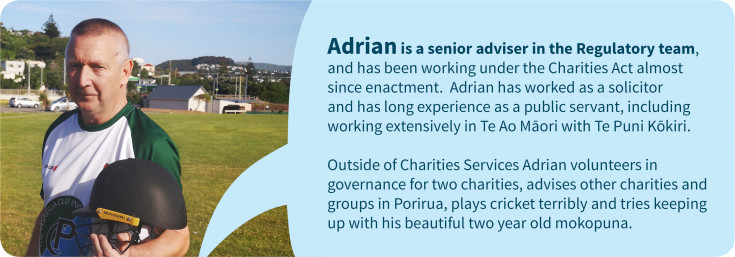Options when ending a charity
blogs

Published 20 February 2020
[![]() 5 minutes to read]
5 minutes to read]
We previously published a blog� which explained what registered charities should consider when they are coming to the end of their life. After receiving a number of comments and questions, we thought it would be worth explaining some practical tips for charities when winding up. This includes some options for charities when they want to wind up, but they still have funds left over.
Practical tips
Winding up can be a stressful time for charitable groups. The following steps may help:
Read your rules carefully to understand what you can do. If they aren’t clear, seek advice from a professional.
Make a plan so when it comes to winding up you stick to the agreed upon process – share this plan and get agreement (where possible) with beneficiaries, stakeholders and officers.
Think carefully about how your bank accounts are going to be managed, and how payments are going to be made. Ensure that all payments (including final payments) are appropriately signed off.
Be transparent in order to manage risk (for example: a letter on paper or on your website as to why you are winding up, and record clear statements and resolutions in meeting minutes).
If the charity has significant capital assets (e.g. property or expensive equipment) it may be worth seeking professional advice on how they can be dealt with.
Find out what you need to do to ensure any tax liabilities are paid up. This may include GST and PAYE. If your organisation is a Company, you will need to obtain a “letter of no objection” from IRD to upload to the Companies Office.[1] For more information, go to the Companies Office
 and Inland Revenue.
and Inland Revenue.
Don’t forget the small details (for example: you’ll need to close bank accounts, make sure the final papers to close down the entity are completed – this may involve liquidation, or simply making a resolution in a meeting to end your unincorporated group).
Think about the charity’s social media accounts – you’ll need to either close them, or transform them into something else. If you are going to keep them, think about photos and other intellectual property – if they are only licenced to the charity, you won’t be able to use them for another group – unless the terms of your licence/authority let you.
If you have goods that may be reusable, you can search the Charities Register
 to identify other charities that may benefit from these goods (after dealing with any outstanding debts and/or liabilities).
to identify other charities that may benefit from these goods (after dealing with any outstanding debts and/or liabilities).Remember to log into
 your charities portal and fill out a voluntary deregistration form - you can choose a date to deregister in the future or past.
your charities portal and fill out a voluntary deregistration form - you can choose a date to deregister in the future or past.
Options for giving your money to a charitable purpose
When you are removed from the Charities Register, you have 12 months to decide what to do with the charity’s funds – or there may be tax consequences�.
As explained in the previous blog, your first stop is your rules: your rules will explain how you can distribute your funds and what limitations there are.
Sometimes a specific organisation is named. If that is the case you should distribute to that organisation. If the rules say the funds must go to “charitable purposes” or “similar charitable purposes”, then you have the power to decide. Here are some options for you to consider:
Distribute the funds to another charity (e.g. this may be another group doing similar work in the community)
Distribute to a group that will use the funds for charitable purposes (for example: giving it to the council to use on a local facility)
Distribute funds to a community foundation or other donor advised fund.
Community foundations are independent registered charities that manage funds in communities across New Zealand. They are “donor advised funds”, which means that you can give to the fund and still guide where you want the interest from your funds to go. This is helpful as you don’t have to set up a separate charity, manage reporting with Charities Services or deal with any of the ongoing administration of running your own charity and if you decide to wind up your trust it can mean your original purpose can continue on.
There are 17 community foundations across New Zealand, and more information is available on is available on the New Zealand Community Foundation’s website![]() .
.
There are other donor advised funds. The Gift Trust
 is a donor advised fund that operates nationally. They can support trusts that are looking at winding up, and have a purpose that is directed at the whole of New Zealand. We are looking to add to our list of donor advised funds so if you are a charity who engages in similar services, we are happy to add you to this list – just get in contact with us.[2]
is a donor advised fund that operates nationally. They can support trusts that are looking at winding up, and have a purpose that is directed at the whole of New Zealand. We are looking to add to our list of donor advised funds so if you are a charity who engages in similar services, we are happy to add you to this list – just get in contact with us.[2]
We recommend when making decisions on donating or giving surplus funds to a specific charity, you look at the charity’s performance reports on the Charities Register![]() to see if you agree with how they are spending their money (and charities are usually happy to discuss if you want to know more information).
to see if you agree with how they are spending their money (and charities are usually happy to discuss if you want to know more information).
If you read anything on our website, or our blogs and you have more questions, don’t hesitate to contact us. We may be able to answer, or address the issue in a future blog, or amend the website materials.
[1] As discussed in the previous blog, MBIE (The Ministry of Business, Innovation and Employment) look after the Companies Register, the Register of Incorporated Societies![]() and the Register of Charitable Trusts
and the Register of Charitable Trusts![]() . If your charity is listed on any of these registers as well as the Charities Register held at Department of Internal Affairs, you will need to be removed from both registers.
. If your charity is listed on any of these registers as well as the Charities Register held at Department of Internal Affairs, you will need to be removed from both registers.
[2] Please note that the Department does not endorse any particular fund, you will need to do your own due diligence to ensure that the service is right for your charity.

